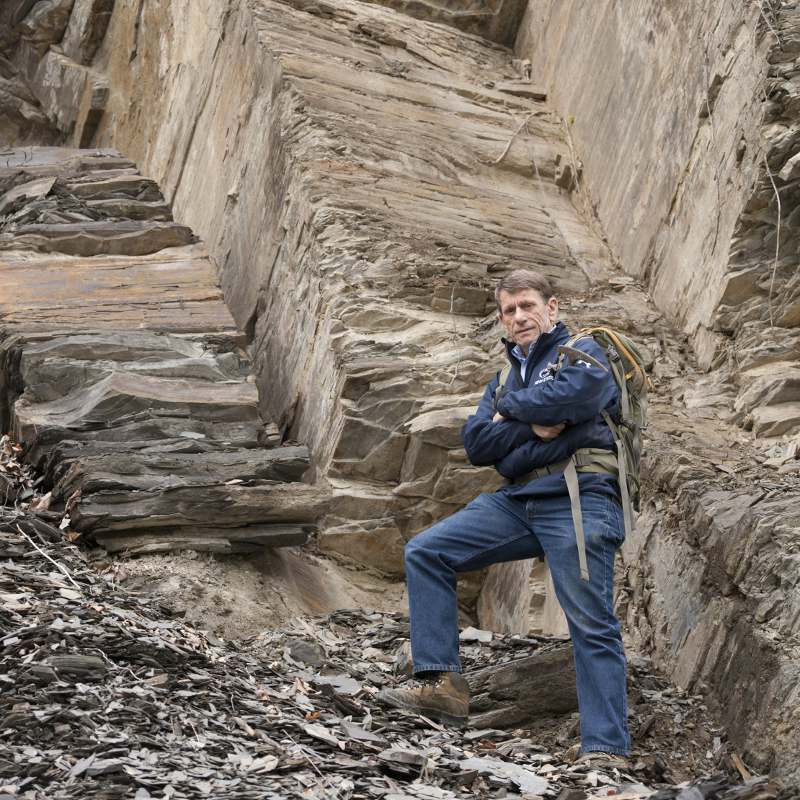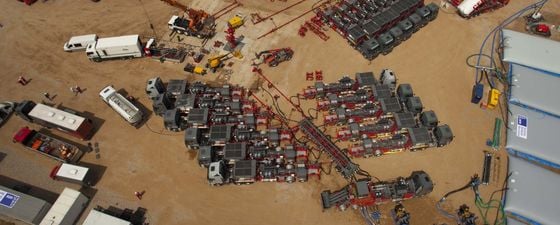During a recent trip to Europe as part of my AAPG Distinguished Lecture Tour, my most popular lecture proved to be an analysis of the fracking debate ‘The Environmental Realities of Hydraulic Fracturing: Fact versus Fiction’ – unsurprising considering the sensitivity to the prospect of shale gas exploration in much of the continent. My objective was to address the public fears that drove moratoria on fracking in places as different as New York, the UK, and France.
 Unpaved McConnell Road passes by many Marcellus Shale gas-drilling sites as it traverses the state forest, August 2010. (Source: Nicholas A. Tonelli)Central causes of public fear in America were a combination of early mistakes by industry and purposeful disinformation from activists, especially those seeking to profit from such anxieties. This fear has now spread beyond America to places with nothing more than a modest gas industry experience.
Unpaved McConnell Road passes by many Marcellus Shale gas-drilling sites as it traverses the state forest, August 2010. (Source: Nicholas A. Tonelli)Central causes of public fear in America were a combination of early mistakes by industry and purposeful disinformation from activists, especially those seeking to profit from such anxieties. This fear has now spread beyond America to places with nothing more than a modest gas industry experience.
My ‘environmental realities’ lecture was a clash between the recalcitrant notion that the worst will happen when the gas industry shows up and my American optimism that gas can be produced at maximum benefit and minimum risk. Several people stated that Europeans do not want fracking until they are sure it is safe. While everyone wants a safe industry, safety is never absolute. In Pennsylvania, for example, where more than 1,000 people are killed annually in automobile accidents, only a handful have died in fracking related accidents since the start of horizontal drilling in 2006. Yet a poll among Pennsylvanians would probably identify driving as the safer activity!
The lecture started with a discussion of my research on natural hydraulic fracturing in gas shale dating back to the 1970s, which was concurrent with both the first horizontal drilling of shale source rocks and the initial use of massive hydraulic fracturing in the US. Although both techniques date back 35 years in the USA, none of this early work on fracking made much of an impression on the public.
Risks and Rewards
The process by which fracking entered the general consciousness may have started about 2007 with my calculation of the technically recoverable reserves in the Marcellus gas shale of the Appalachian Basin. In late 2007 I went to the news media with my results, receiving a great deal of public attention. At that time the term fracking was not part of the English language; within two years it had become shorthand for gas extraction by horizontal drilling and high volume hydraulic fracturing, and most people now know what fracking is.
In Europe, I was frequently asked, “How can you be so certain [about fracking]”? My American optimism must have been shining through, because I point out in the lectures that shale gas comes with risk along with reward. As Voltaire said: “Doubt is not a pleasant condition, but certainty is absurd.” Science is not capable of certainty beyond having a sense of when others are mistaken.
As the automobile fatalities example shows, people don’t do a very good job of normalizing risk. When asked for absolute numbers on risk, all I can do is point to the millions of hydraulic fracture treatments and stimulations undertaken already, resulting in a modest number of examples of groundwater contamination from subsurface sources, virtually all from methane leaking along the cement-bedrock contact inside a borehole. Risks outside methane leakage come from poor surface management of fluids in the form of spills and leaks.
Air quality is at risk and ultimately, burning methane leaves a carbon footprint. These are concerns. The leaks need to be found and fixed – but replacing coalfired power plants with natural gas led to a significant reduction in America’s carbon footprint over the past five years, according to the EIA. This good news does not mean that mankind should discontinue its march toward a larger renewable energy portfolio.
A Number of Mistakes
Industry was responsible for six major ‘mistakes’ during the early days of high-volume horizontal hydraulic fracturing in the Appalachian Basin. I use the term mistake, because each might have been anticipated, but only by someone with great clairvoyance. None was a manifestation of single events like the engineering carelessness of the Macondo well blowout. However, they did create a breeding ground for amplifying public fear of the unknown.
Arguably, the most serious one was the failure to establish baseline water chemistry before drilling campaigns. Many chemical elements, (e.g. iron, magnesium, potassium) and compounds (e.g. methane) are dissolved in drinking water, but when water chemistry is measured after the arrival of industry, there is a belief that these chemicals, particularly methane, result from drilling.
Traditionally, the first oil wells in a region were drilled where oil is leaking to the surface. Methane was there all along but industry failed to present these details to the public prior to drilling. Pennsylvania, for example, had a long history of flaming faucets and bubbling stream beds, although the gas was not usually concentrated sufficiently in groundwater to manifest itself in drinking water. Intensified drilling in 2008 produced a heightened sensitivity to methane in groundwater, but with no baseline, it was impossible to know whether and how much methane resulted from this drilling. Pennsylvania law held operators responsible for the methane in groundwater within 1,000 ft of a gas well, regardless of whether it was their fault.
The second industry mistake involved the extent to which casing was cemented. Early on, surface and intermediate casing was completely cemented but as much as 5,500 ft of open hole was left outside the production casing, as traditionally done in sparsely populated parts of the country with few water wells near gas wells. This is fine if the overburden section is not gas charged – but in north-eastern PA the overburden contains Upper Devonian coals, full of methane gas, which flowed into the open holes and in some cases likely increased groundwater concentration by leaking along poorly cemented gas wells. Industry no longer leaves open-hole production casing, at least below the intermediate casing string.
Secrecy and Earthquakes
 Terry Engelder is Professor of Geosciences at Pennsylvania State University and a leading authority on the Marcellus gas shale play. (Source: John Beale)The use of air-drilling to penetrate the vertical legs of Marcellus gas wells was another error. The pressure of air blowing into more permeable aquifers was sufficient to drive methane towards nearby water wells. It also increased the natural turbidity in groundwater, which often worries people.
Terry Engelder is Professor of Geosciences at Pennsylvania State University and a leading authority on the Marcellus gas shale play. (Source: John Beale)The use of air-drilling to penetrate the vertical legs of Marcellus gas wells was another error. The pressure of air blowing into more permeable aquifers was sufficient to drive methane towards nearby water wells. It also increased the natural turbidity in groundwater, which often worries people.
A fourth mistake was to lobby for elements in the Energy Policy Act of 2005 that allowed fracking companies to keep their additives proprietary. The public feared that groundwater would become contaminated by unknown, possibly toxic, chemicals, and wanted to understand exactly what and how much was being pumped into the ground. There was also the (inaccurate) perception that this act exempted the industry from Clean Water and Clean Air Acts. The industry elected to reveal the details of additives on a website, ‘Frac Focus’, and, while posting volume and chemical composition was voluntary, most operators in the Appalachian Basin have joined in an attempt to become more transparent.
The industry disposed of flowback in large enough volumes to trigger minor earthquakes in Ohio and Texas, which naturally played into the public fear. Water under pressure flowing along faults reduces the frictional strength sufficiently to cause slip; triggering a large earthquake by injecting water was even the plot of a James Bond movie. USGS studies confirmed that there is a relationship between the injected volume of water and earthquake size, but showed that it was not possible to trigger a destructive earthquake with the amount of water used during fracking – incidentally proving the implausibility of the James Bond plot.
The sixth mistake involved management issues associated with potentially leaking open pits, leading to the fear that groundwater could be contaminated if a lined pit was punctured or seals failed. Presently, only fresh water is stored in open pits. Any flowback is contained in enclosed frack tanks where the chance of leaking is near zero.
Purposeful Disinformation?
Public anxiety arising from these very real mistakes was easily manipulated and magnified by activists who either did not know better or sought to profit by playing to this fear. The most egregious case of purposeful disinformation being used to manipulate the public is found in the closing scene of the movie, ‘Gasland’, where a tap is lit. The owner’s water well was drilled though a coal bed giving off methane, and the film’s producer admitted knowing that the methane had nothing to do with fracking.
Public fear can also be manipulated by famous people. Movie star, Matt Damon, was quoted as saying that ‘Everyone knows that fracking poisons the water and air’, adding that fracking, ‘…tears apart local communities and subverts democracies….’ Yoko Ono was quoted in the media as stating categorically that, ‘Fracking kills’. Subsequently, signs declaring that fracking kills have shown up regularly at protest rallies in many places worldwide.
The most common prop at protest rallies has been the jug of rusty, brown water – easily transported and, unlike the flaming faucet, looking nasty enough to amplify fear of fracking. Rusty, brown water is a natural product of the oxidation of dissolved iron. Tests suggest that nearly half the water wells in parts of Pennsylvania have enough dissolved iron in the groundwater to make it turbid when exposed to atmospheric oxygen, a process accelerated by pumping wells dry. In fact, the US EPA tested one water well repeatedly and found the water safe to drink. Later, the owners admitted pumping their water well dry to supply turbid water when visitors came knocking.
In summary, public pressure was largely responsible for political decisions to place moratoria or bans on fracking. In a sense, industry was directly responsible for these political decisions because of early mistakes, making it easy for activists using purposeful disinformation to further cement a negative public position relative to fracking.
 Chart showing 2013 unproved wet shale gas technically recoverable resources for selected European countries. (Source: Source: EIA/ARI)
Chart showing 2013 unproved wet shale gas technically recoverable resources for selected European countries. (Source: Source: EIA/ARI)





